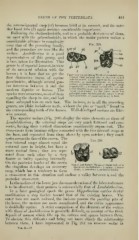Page 471 - My FlipBook
P. 471
TEETH OF THE VERTEBRA TA. 481
the antero-internal cusp (a I) becomes bifid at its summit, and the ante-
rior basal lobe (k) again assumes considerable importance.
Following the chalicotherioids, and as a probable derivative of them,
we meet with the pakeotherioids, in which the molar pattern makes a
considerable advance in complexity
over that of the preceding family,
and the premolars are now like the j^tti'tii
molars. Anchitherium is a erood
representative of this group, and ace
is here taken for illustration. This
genus is of especial interest, in view
of its ancestral relation with the
horses ; it is here that we get the
Upper and Lower Molar Tei'th ol' Larnhdolhirmm,
first distinctive traces of equine vertical view, natural size: a, su| erior; 6, last
inferior molar. In the upper molar, at-, antero-
peculiarities, although several gen- external ; pe, postero-external; at, antero-in-
ternal; /j(', posterointernal or principal cusps
era intervene between it and the
respectively
; //, external vertical rib ; x, an an-
modern Equidse or horses. The terior cingular cusp ; ace-pcc, anterior and pos-
terior cross-crests. In the lower molar the
species were numerous, most ofthem principal cusps are lettered the .same : A-, ante-
rior basal lobe; «/', accessory cusp; A, heel.
equalling the sheep in size, and had
three subequal toes on each foot The incisors, as in all the preceding
genera, are plain incisiform teeth, without the pits or "mark" found in
the corresponding teeth of the horses. Well-developed canines are like-
wise present.
The superior molars (Fig. 260) display the same elements as those of
Lambdotheriuin ; the external cusps are very much flattened and cres-
centic, having their vertical dimensions considerably augmented. The
cross-crests form laminar ridges connected with the two internal cusps at
the base, and separated from them above by open notches ; they reach
quite across the face of the crown. The
two internal cusps almost equal the
external ones in height, but have a
more conical form ; they are sepa-
rated from each other by a deep
fissure or valley opening internally.
On the posterior border of the crown
Upper and Lower Molars of Right Side of a
the cingulum develops an accessory species of A7tc/iil/ieriu)ii : 1, upper; 2, lower
tooth; (/, anterior ; ft, posterior border.
cusp, which has a tendency to form
a cross-crest in this situation and enclose a valley between it and the
posterior cross- crest.
In the molars of the lower jaw the same elevation of the lobes and crests
is to be observed ; their pattern is substantially that of Lambfhfherium.
In a later geological epoch the genus Hippotherium carries dental
modification a step farther toward that of the existing horses. The
outer toes are much reduced, the incisors possess the peculiar pits of
the horse, the molars are more complicated, and the entire appearance
is decidedly equine. A strict comparison of the elements of the molars
with those of Anchitherium is generally difficult, on account of the thick
deposit of cement which fills up the valleys and spaces between them.
To obviate this difficulty and bring out more clearly the relationship
between them, I have represented in Fig. 261 an unworn molar in
Vol. I.—31


